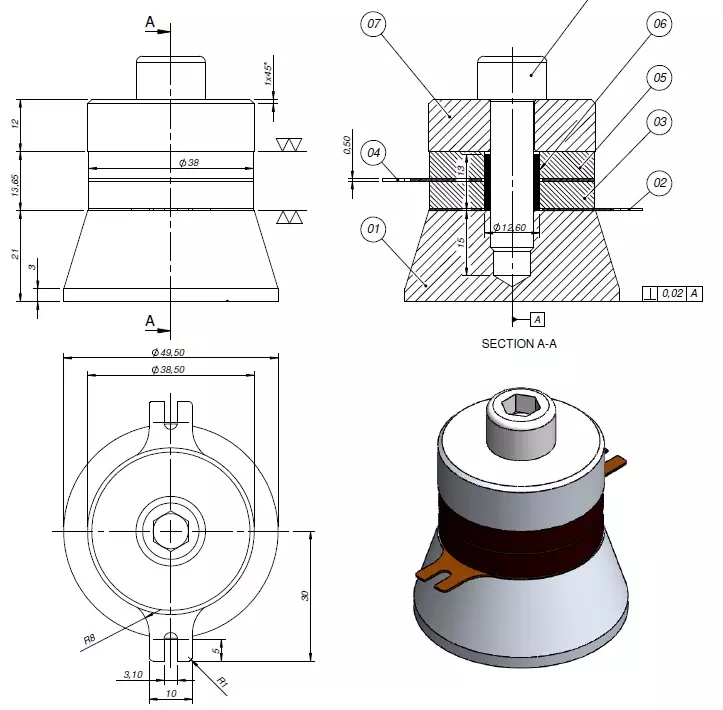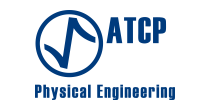FAQ: We started using the TRZ® Analyzer by reading its manual, but I have a question about the transducer design. Do you have any practical guidelines on developing transducers? I would appreciate if you could help us on this issue. Mr. H.B.

Design of ultrasonic cleaning transducer that can be tested and tuned with the TRZ® Analyzer.
We will gladly share our experience and assist you; however, we do not have a practical guide for transducers design. The approach and difficulty level will depend whether you have a reference transducer or if you are starting from scratch. Replicate a transducer, even if not planning any improvement or innovation may be a tough and multidisciplinary task. In our experience, the main challenges of development, having a reference transducer, are as follows:
Selecting materials - It is not enough to know if it is titanium, aluminum or steel, it is also necessary to know the alloys, heat treatments and hardness. Differences in material will imply changes in elastic properties, vibration efficiency and resistance to fatigue. Changes in elastic properties cause changes in the frequency and may unbalance the nodal point. Changes in efficiency may reduce the maximum amplitude of vibration. Changes in resistance to fatigue affects the service life. You can measure the resonance and anti-resonance frequencies with the TRZ® Analyzer and evaluate the vibration efficiency by the mechanical quality factor Qm.
Machining and tuning - The frequency of the device and its length are inversely proportional (the longer the part the lower the frequency). Dimensional inaccuracies and surface poor finishing result in frequency variations. Since tolerances in machining are inevitable, it will be almost certainly necessary to fine tune transducers, sonotrodes and ultrasonic tips. The tuning is usually performed with shortening and bend angle adjustment in the case of curved tips. Note: You can use the TRZ® Software to graphically record the frequency changes along with the tuning process and also establish reference curves.
Balancing the nodal point - There are many models of transducers that have a housing by which it is held or fixed in order to be used, but the fixation region should be a nodal line. If the fixation region vibrates, it will dampen the vibration and reduce the amplitude of vibration. Similar to a wheel in which the axle needs to be positioned exactly in the middle, a transducer must be fixed at the nodal line. The difficulty here is that nodal line is an acoustic equilibrium line and not a geometrical midpoint or center of mass. Changes on one side of the transducer, such as elastic properties variations, can cause mismatch between the nodal line and fixation position. To assess whether the nodal line is coinciding with the fixation position, one can measure the mechanical quality factor Qm with the TRZ® Analyzer before and after fixation.
Applying prestress – Prestress, or preload, is the static pressure applied to piezoceramics during transducer assembly. It aims to maximize the operating power limit and the mechanical coupling between transducer’s parts, besides avoiding displacements during vibration. Prestress is a key factor for the lifespan, maximum power and efficiency of transducers. Nevertheless, the excess of prestress changes the properties of the ceramics and may cause crushing; whilst the lack of it causes the lateral displacement of the ceramics in high power, leading to cracks, electric arcs and short circuits. Essentially, the optimum prestress depends on the maximum mechanical stress supported by the piezoelectric material and stress distribution over the ceramics. Typical values are 45 MPa for PZT-8 and 35 MPa for PZT-4. To control prestress, one can use the PiezoClamping® test instrument.
Sealing - Many medical transducers have saline circulation and this is a common cause of leakage problems. Special attention is needed with the seal to prevent these problems from occurring.
With regards to developing from scratch, it demands extensive multidisciplinary background and previous experience is highly welcome. Besides the points listed above, it is necessary to establish the amplitude of vibration and carefully evaluate the stress distribution and nodal points in the project. Software tools for Finite Element Analyses are helpful. At ATCP, we are experienced at assisting our customers with the replication, refurbishing and performing quality control of ultrasonic transducers for industrial and medical applications; however, our experience in assisting our customers to develop from scratch is limited.
Learn more about testing converters and acoustic stacks.
